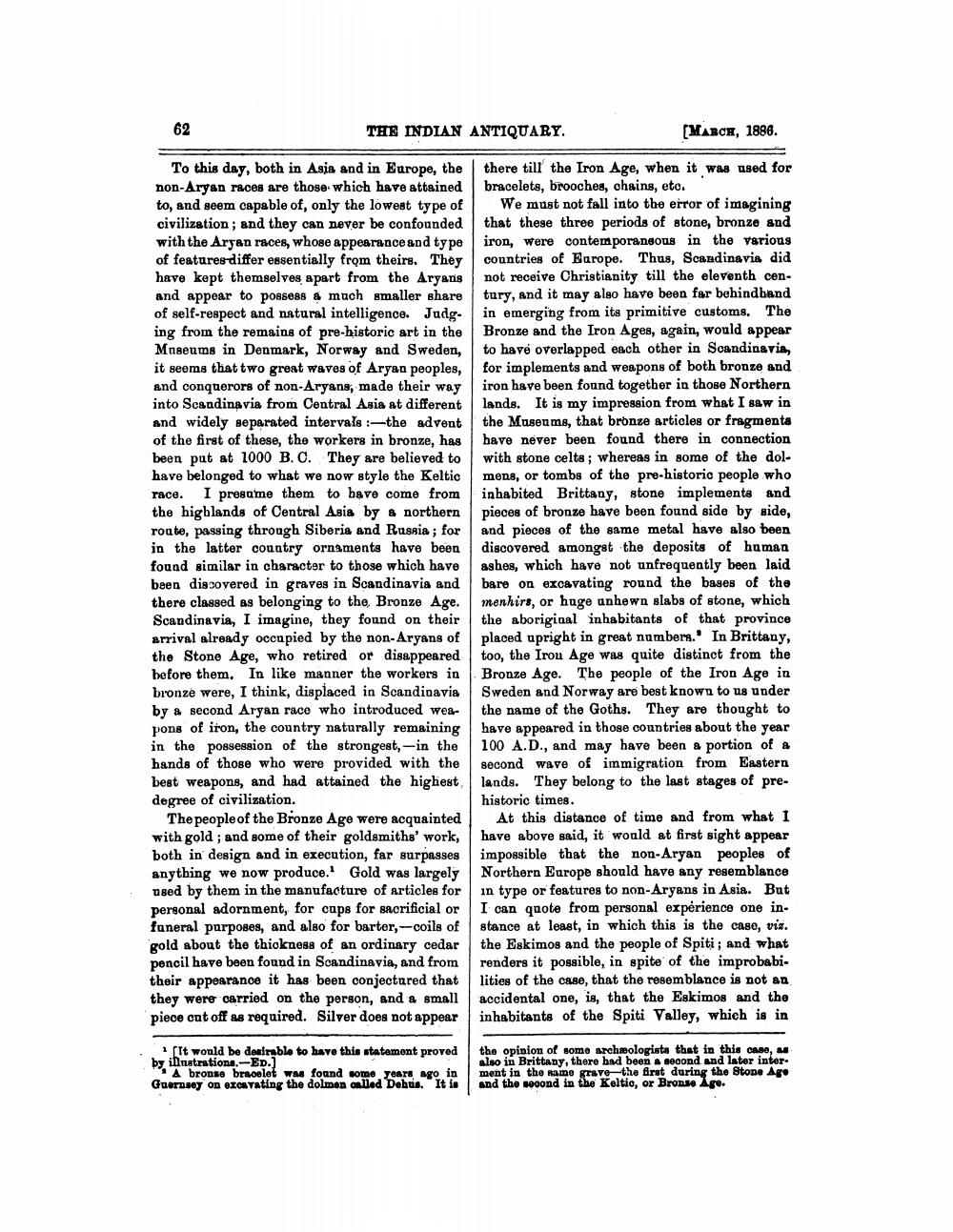________________
62
THE INDIAN ANTIQUARY.
(MARCE, 1886.
To this day, both in Asia and in Europe, the there till the Iron Age, when it was ased for non-Aryan races are those which have attained bracelets, brooches, chains, etc. to, and seem capable of, only the lowest type of We must not fall into the error of imagining civilization, and they can never be confounded that these three periods of stone, bronze and with the Aryan races, whose appearance and type iron, were contemporaneous in the various of features differ essentially from theirs. They countries of Europe. Thus, Scandinavia did have kept themselves apart from the Aryans not receive Christianity till the eleventh cenand appear to possess & much smaller share tury, and it may also have been far behindband of self-respect and natural intelligence. Judg. in emerging from its primitive customs. The ing from the remains of pre-historic art in the Bronze and the Iron Ages, again, would appear Museums in Denmark, Norway and Sweden, to have overlapped each other in Scandinavia, it seems that two great waves of Aryan peoples, for implements and weapons of both bronze and and conquerors of non-Aryans, made their way iron have been found together in those Northern into Scandinavia from Central Asia at different lands. It is my impression from what I saw in and widely separated intervals :-the advent the Museums, that bronze articles or fragmenta of the first of these, the workers in bronze, has have never been found there in connection been put at 1000 B.C. They are believed to with stone celts; whereas in some of the dolhave belonged to what we now style the Keltic mens, or tombs of the pre-historic people who race. I presume them to have come from inhabited Brittany, stone implements and the higblands of Central Asia by a northern pieces of bronze have been found side by side, roate, passing through Siberia and Russia ; for and pieces of the same metal have also been in the latter country ornaments have been discovered amongst the deposits of human found similar in character to those which have ashes, which have not unfrequently been laid been discovered in graves in Scandinavia and bare on excavating round the bases of the there classed as belonging to the Bronze Age. menhirs, or huge unhewn slabs of stone, which Scandinavia, I imagine, they found on their the aboriginal inhabitants of that province arrival already occupied by the non-Aryans of placed upright in great numbers.' In Brittany, the Stone Age, who retired or disappeared too, the Iron Age was quite distinct from the before them. In like manner the workers in Bronze Age. The people of the Iron Age in bronze were, I think, displaced in Scandinavia Sweden and Norway are best known to us under by a second Aryan race who introduced wea- the name of the Goths. They are thought to pons of iron, the country naturally remaining have appeared in those countries about the year in the possession of the strongest, -in the 100 A.D., and may have been a portion of a hands of those who were provided with the second wave of immigration from Eastern best weapons, and had attained the highest, lands. They belong to the last stages of predegree of civilization.
historic times. The people of the Bronze Age were acquainted At this distance of time and from what I with gold; and some of their goldsmiths' work, have above said, it would at first sight appear both in design and in execution, far surpasses impossible that the non-Aryan peoples of anything we now produce.' Gold was largely Northern Europe should have any resemblance used by them in the manufacture of articles for in type or features to non-Aryans in Asia. But personal adornment, for cups for sacrificial or I can quote from personal experience one in. funeral purposes, and also for barter, --coils of stance at least, in which this is the case, vis. gold about the thickness of an ordinary cedar the Eskimos and the people of Spiti; and what pencil have been found in Scandinavia, and from renders it possible, in spite of the improbabitheir appearance it has been conjectured that lities of the case, that the resemblance is not an they were carried on the person, and a small accidental one, is, that the Eskimos and the piece cut off as required. Silver does not appear inhabitants of the Spiti Valley, which is in
[It would be desirable to have this statement proved by ilustrations.-ED.)
A bronse bracelet was found some years ago in Guernsey on excavating the dolmen alled Dehus. It is
the opinion of some archæologists that in this case, also in Brittany, there had been a second and later interment in the same grave the first during the Stone Age and the second in the Keltic, or Bronse Age.




